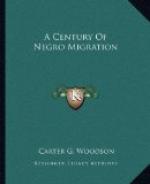In cities far north like Boston not so much difference as to the result of this migration was noted. Some economic progress among the Negroes had early been observed there as a result of the long residence of Negroes in that city as in the case of Lewis Hayden who established a successful clothing business.[9] In New York such evidences were more apparent. There were in that city not so many Negroes as frequented some other northern communities of this time but enough to make for that city a decidedly perplexing problem. It was the usual situation of ignorant, helpless fugitives and free Negroes going, they knew not where, to find a better country. The situation at times became so grave that it not only caused prejudice but gave rise to intense opposition against those who defended the cause of the blacks as in the case of the abolition riots which occurred at several places in the State in 1834.[10]
To relieve this situation, Gerrit Smith, an unusually philanthropic gentleman, came forward with an interesting plan. Having large tracts of land in the southeastern counties of New York, he proposed to settle on small farms a large number of those Negroes huddled together in the congested districts of New York City. Desiring to obtain only the best class, he requested that the Negroes to be thus colonized be recommended by Reverend Charles B. Ray, Reverend Theodore S. Wright and Dr. J. McCune Smith, three Negroes of New York City, known to be representative of the best of the race. Upon their recommendations he deeded unconditionally to black men in 1846 three hundred small farms in Franklin, Essex, Hamilton, Fulton, Oneida, Delaware, Madison and Ulster counties, giving to each settler beside $10.00 to enable him to visit his farm.[11] With these holdings the blacks would not only have a basis for economic independence but would have sufficient property to meet the special qualifications which New York by the law of 1823 required of Negroes offering to vote.
This experiment, however, was a failure. It was not successful because of the intractability of the land, the harshness of the climate, and, in a great measure, the inefficiency of the settlers. They had none of the qualities of farmers. Furthermore, having been disabled by infirmities and vices they could not as beneficiaries answer the call of the benefactor. Peterboro, the town opened to Negroes in this section, did maintain a school and served as a station of the Underground Railroad but the agricultural results expected of the enterprise never materialized. The main difficulty in this case was the impossibility of substituting something foreign for individual enterprise.[12]




